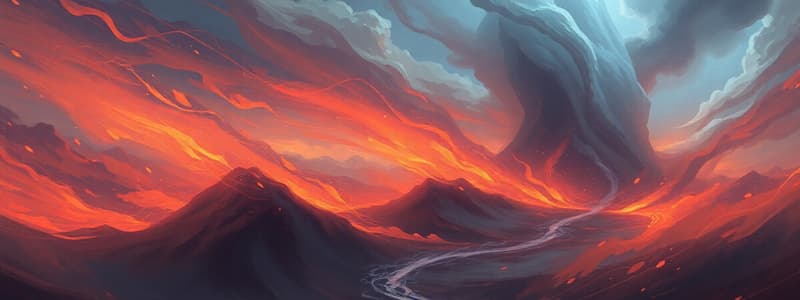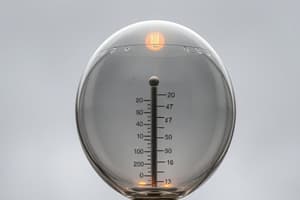Podcast
Questions and Answers
What is wind?
What is wind?
The movement of air molecules in the atmosphere.
Wind is a force that only moves from a high-pressure area to a low-pressure area.
Wind is a force that only moves from a high-pressure area to a low-pressure area.
True (A)
What happens to the air on surfaces with higher temperatures?
What happens to the air on surfaces with higher temperatures?
It begins to rise.
What causes uneven heating on the Earth's surface?
What causes uneven heating on the Earth's surface?
Flashcards
What is wind?
What is wind?
The movement of air molecules in the atmosphere, usually from a high-pressure area to a low-pressure area.
How does uneven heating create wind?
How does uneven heating create wind?
Areas with higher temperatures have rising air, creating low atmospheric pressure. Areas with cooler temperatures have sinking air, creating higher atmospheric pressure.
What is the Ferrel Cell?
What is the Ferrel Cell?
A theoretical model explaining the movement of air between 35° and 60° North/South latitude, characterized by poleward and eastward surface air movement.
Describe the Polar Cell.
Describe the Polar Cell.
Air rises near the poles, travels towards the poles, then sinks creating areas of high pressure, generating eastward surface winds called 'polar easterlies'.
Signup and view all the flashcards
What are high-pressure bands?
What are high-pressure bands?
Locations where air descends, creating high atmospheric pressure.
Signup and view all the flashcards
What are low-pressure bands?
What are low-pressure bands?
Locations where air ascends, creating low atmospheric pressure.
Signup and view all the flashcards
What are monsoons?
What are monsoons?
A pattern of winds created by temperature differences between land and ocean surfaces.
Signup and view all the flashcards
Describe the summer monsoon.
Describe the summer monsoon.
Land warms more quickly than the sea during the summer, drawing moist air from the ocean, causing rain.
Signup and view all the flashcards
Describe the winter monsoon.
Describe the winter monsoon.
Land cools faster than the sea during the winter, causing dry winds to blow from land to the ocean.
Signup and view all the flashcards
Describe the general circulation of air in the troposphere.
Describe the general circulation of air in the troposphere.
Caused by air rising and sinking due to temperature differences within the troposphere, with three main cells: Hadley, Ferrel, and Polar.
Signup and view all the flashcards
What is the Hadley Cell?
What is the Hadley Cell?
The dominant wind pattern in the tropics, characterized by air rising at the equator, moving poleward, and descending at 30° North/South.
Signup and view all the flashcards
How does the Coriolis effect influence Hadley Cell winds?
How does the Coriolis effect influence Hadley Cell winds?
The Coriolis effect causes the Hadley Cell's winds to deflect to the right in the Northern Hemisphere and to the left in the Southern Hemisphere.
Signup and view all the flashcards
What are trade winds?
What are trade winds?
The winds in the Hadley Cell that blow towards the equator, divided into northeast trade winds in the Northern Hemisphere and southeast trade winds in the Southern Hemisphere.
Signup and view all the flashcards
What is the Coriolis effect?
What is the Coriolis effect?
The tendency of moving objects, like air, to deflect to the right in the Northern Hemisphere and to the left in the Southern Hemisphere due to Earth's rotation.
Signup and view all the flashcards
How does friction affect wind direction?
How does friction affect wind direction?
Friction between the air and Earth's surface, which further influences wind direction.
Signup and view all the flashcards
What is the significance of atmospheric circulation cells?
What is the significance of atmospheric circulation cells?
A key feature of Earth's climate system, influencing wind patterns, precipitation, and temperature distribution.
Signup and view all the flashcardsStudy Notes
Wind
- The atmosphere is composed of air molecules
- The air is free to move in every way unless something is blocking it
- Wind is the movement of air molecules in the atmosphere
- Wind is the flow of a huge amount of air, usually from a high-pressure area to a low-pressure area.
- As a result of uneven heating, there are Earth's surfaces that vary a lot in temperature.
- Air on surfaces with higher temperature begins to rise. As it rises, it creates low atmospheric pressure. Air on surfaces with cooler temperatures sinks. The sinking creates higher atmospheric pressure.
Studying That Suits You
Use AI to generate personalized quizzes and flashcards to suit your learning preferences.




